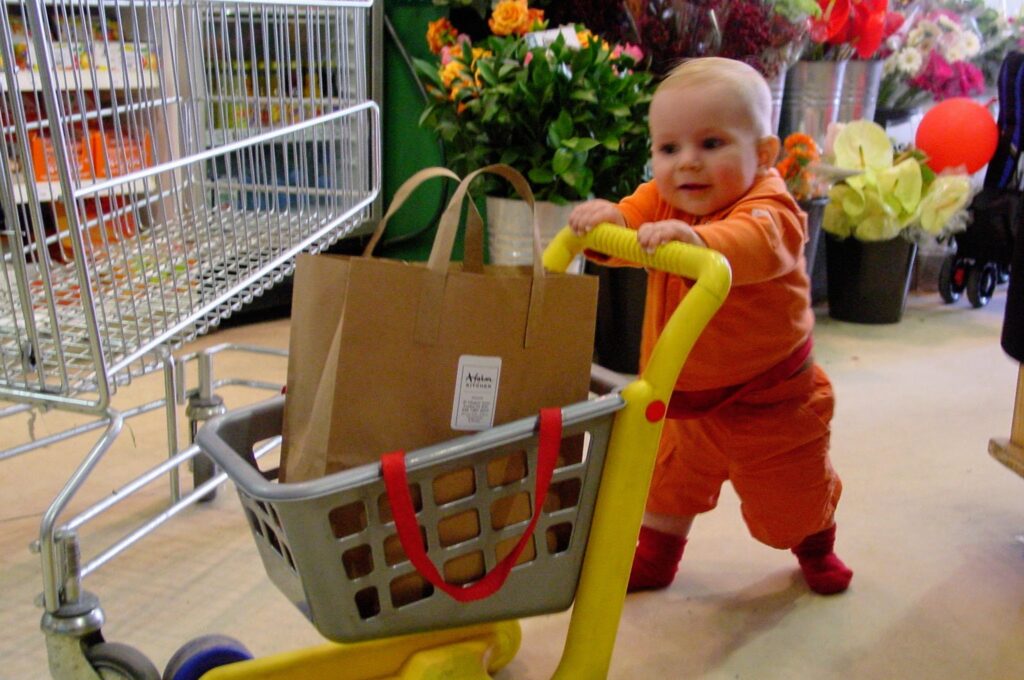Montessori skills at the store with any age child
Following on from our last newsletter about practical life activities and Saniyyah’s beautiful books, today we are going to explore Montessori skills your child can build at the store at any age. There are so many opportunities for children to learn, so instead of planning our shopping trip when there is someone to look after the kids, why not take them with you? This article focuses on the supermarket but it could be any store or at the markets.

Montessori skills being learned at the store
Have you ever thought about how many skills your child can learn in the store? Here are some of the skills they will learn:
- Social development – being part of society, learning to wait our turn in a line, ordering produce from a deli-counter, greeting any staff in the store etc
- Sensorial development – we can show them how to smell the fruit, fish or other. They can feel the weight of 1kg of rice as they place it in the basket. They will hear the sounds at the checkout. They will be able to learn comparatives and superlatives like big, bigger, and biggest.
- Practical life activities – purchasing groceries, making a shopping list, packing and unpacking groceries
- Language development – there is so much vocabulary from giving accurate names of items we see or want to buy (for example, Medjool dates) to using prepositions (for example, “please place the box on top of the cans”) and quantities (for example, 250g of plain yoghurt)
- Mathematics – counting out the number of bananas or oranges, weighing groceries, looking at the price of items, adding up the total to pay, calculating the change, making a family budget, and spending and saving money. They can also learn about buying only what we need, not necessarily what we want.
- Motor skills – gross motor skills like pushing a trolley without bumping into things or people, and carrying bags of shopping home; and fine motor skills of handling items (particularly fragile items) with care
They love to feel part of the family, to feel trusted and responsible, and that they are contributing to the family.
In addition, there are opportunities to learn grace and courtesy. We can show them how we return the trolley when we are done, to use our quiet voices to be respectful for others in the store, to stay together to keep us all safe, saying “please” and “thank you,” asking for assistance, and to look with our eyes.
Grace and courtesy “lessons” in our family are pretty informal. When my kids were small, we’d run through a quick reminder as we were arriving at the store: I’d ask, “Do we run in the store?” They’d chorus, “Noooo.” “Do we shout in the store?” “Noooo.” etc. Perhaps we could have framed the questions in a positive way, but in any case it was a lot of fun and they (generally) stuck to our agreements.
How to involve kids at the store
Montessori families love to be prepared rather than turning up at the store and expecting everything to go smoothly. These skills are scaffolded over time, so that gradually the scaffold can be removed. The ages given are an indication only – always consider your child’s unique development.
With babies (0 – 12 months)
- Our babies will like to be involved being in a carrier, a stroller, or sitting up in the shopping cart
- We can name things as we look for them and place them in the basket
- They can smell produce as we select them, feel textures, hear the sounds of the packaging (and later they will get to taste things too)
- We will be modelling skills like greeting the cashier and putting away our shopping cart when we are done
With toddlers (1 – 3 years)
- Make a visual shopping list for them to be in charge of – start with maybe 5 items and build up to more for older toddler. We can draw a list with them OR cut out items from food magazines or brochures OR print our own with pictures of the items.
- They can push the shopping cart
- Give rich language – for example, when describing the fruit “Those cherries look delicious/delectable/tasty” etc
- Think of jobs for them to do – this is great for using language and numbers. “Can you please hand me the quinoa?” “Would you like to pick two pears?”
- They may wish to hand over the money to pay
- They are learning to wait in line to pay or they may like to help scan items at a self-service checkout
- They love to carry heavy bags (maximum effort) and can help to bring the shopping home, unpack it, and put it in the cupboard or fridge
- At home, we can care for a herb and vegetable (indoor) garden to help them learn where our food comes from
- Continue the sensorial experiences
With preschoolers (3 – 6 years)
- As for toddlers above and…
- Use a visual or written shopping list for them to hold and find the items on the list. Some children may be ready to write their own shopping list. We can look up recipes at home and add ingredients to the list.
- They can do more things with less assistance, for example, weighing fruit and vegetables, pushing the trolley, scanning groceries
- As they get older, they can be more involved in planting and growing herbs and vegetables at home to understand the source of food
- In the store, they can look where the food is grown to encourage them to look at locally grown vs other alternatives
- Again continue sensorial experiences which are important in the first plane of development (0-6 years)
- A fun board game is Shopping List by Orchard Toys – they find the items on their shopping list to fill their shopping cart.
With school-aged children (6-12 years)
- As above and…
- Our child wants more independence at this age and to feel responsible. During this period, depending on where we live, it may be possible for our child to go to the store alone. For those of us in the city, an alternative would be to go to a smaller store and stand by the door to be the chaperone.
- If they get the wrong items or something is not correct, it is an opportunity for them to learn. Try not to lecture. We can show them how to fix their error if needed and how to do it differently for next time.
- They can look up recipes they’d like to make and write a shopping list. They can also take a family budget into consideration if needed. They might like to be responsible for planning and cooking one night a week.
- At this age, they can become interested in big ideas and using their imagination – they may invent something or plan a garden or write their own recipe book etc.
With adolescents
- As above and…
- They can go to the store independently, manage a budget, take responsibility for cooking one or two nights a week. The recipes will have increasing difficulty.
- They may like to be involved in a community garden project – adolescents need to do big work with their muscles and to be part of a group.
I hope this inspires you to take your children to the store and to remember all of the Montessori skills they will be learning along the way. Through trips to the store they become part of the family and soon part of society.

Simone Davies has more than 20 years’ experience as an AMI Montessori educator. Simone is the author of “The Montessori Toddler” and co-author of “The Montessori Baby” and “The Montessori Child” books, comprehensive guides to raising children in a Montessori way. She currently runs parent-child Montessori classes in Amsterdam at her school Jacaranda Tree Montessori. She also has a popular blog, instagram and podcast “The Montessori Notebook” and is mother to two young adults.